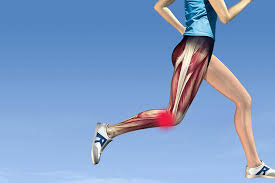Illiotibial Band Syndrome
Aetiology (What is it?)
Iliotibial Band Syndrome (ITBS) is a common knee injury that presents with pain on the lateral aspect (outside) of the knee. ITBS is not to be confused with Patellofemoral Pain Syndrome (PFPS) where pain is present at the anterior (front) of the knee or under the patella.
ITBS is thought to be an overuse injury caused by repetitive knee flexion and knee extension, concomitant with weak hip abductors. ITBS has high prevalence in long distance runners, and cyclists.
Pathophysiology (What’s happening?)
In the past, ITBS was thought to be caused by friction between the Iliotibial Band (ITB) and the lateral condyle of the femur (LFE) leading to inflammation of bursa between the ITB and LFE. However, recent anatomical studies do not support the presence of a bursa around the LFE. Instead it is suggested that a highly innervated and vascularised layer of fat between the ITB and LFE is the source of ITBS pain.
The ITB is a thick band of fascia, composed of very dense fibrous connective tissue that runs down the outside of the thigh from the iliac crest (hip bone) and inserts into the outside of the knee. As the ITB is fascia and not muscle, it is resistant to stretching and foam rolling.
So, what causes ITBS? It is currently believed that the source of the problem is usually weak hip abductors (Gluteus medius and gluteus minimus). Weakness here may cause excessive hip medial rotation and knee adduction leading to abnormal loading on the ITB at the knee. A weak core can also cause instability in the pelvis.
Signs and Symptoms
- sharp pain on the lateral aspect of the knee
- crepitus and local swelling may be present
- pain is worse when running (especially downhill) or when walking downstairs
Risk factors
- lots of downhill running
- running on cambered courses such as track and field course. This means the pelvis is always tilted and one leg is always “longer”. This can also happen when running on the side of the road with the footpath cambered toward the road. To lessen the effect, try to run in both directions on a track, and run on both sides of the road if road running.
- Leg length discrepancy (same reasons as above)
- Pronated feet
- weak hip abductors and core
Medical treatment options
As always, in the acute phase, you should see your physiotherapist for diagnosis. The physio may suggest a regime of icing and anti-inflammatories to reduce the pain, and possibly a period of rest.
Although the pain is felt distally at the knee, most treatment will be focussed proximally at the hips. Strength exercises will be given to target weak muscles in the hip. Resisted hip abduction (standing with thera-band around ankles, and taking leg out to the side), clamshells, and one-legged squats are useful exercises for stabilising the hips.
Massage is useful to lengthen muscles such as tensor fascia latae (TFL), Gluteus maximus, and or vastus lateralis that are placing increased tensile load on the ITB. There are often trigger points present in TFL, Gluteus medius and gluteus minimus. Ischaemic pressure or dry needling may be used to alleviate symptoms caused by these trigger points.
Prevention: Implementing a regular strength and flexibility routine is important to add to your running regime. Exercises targeting core and glutes will help your hips to remain stable. Foam rolling to TFL, Vastus lateralis and glute max. And of course, regular sports massage is great to add to your toolkit for injury prevention.
References
https://physioworks.com.au/injuries-conditions-1/iliotibial-band-friction-syndrome
https://www.physio-pedia.com/Iliotibial_Band_Syndrome
https://emedicine.medscape.com/article/91129-overview#a5
https://bestpractice.bmj.com/topics/en-us/587
https://www.sports-health.com/sports-injuries/leg-injuries/iliotibial-band-syndrome
http://www.ucsfcme.com/2016/MOR16002/slides/15MaKneeRedFlagsWhatNotTooMiss.pdf

